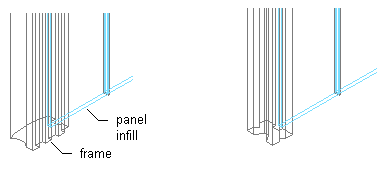Use this procedure to create a frame element definition from a profile. If you do not want a straight edge to your frame, you can use a profile to define edges with curves, jags, or any other shape you require.
You can also use an edit in-place routine to create a frame from a profile.

Two profile-based frame examples
Note: The insertion point of the profile is aligned with the centroid of the frame.
- Create the profile for the frame.
- Click

 .
. 
- Expand Architectural Objects, and expand Curtain Wall Styles.
- Select a curtain wall style.
- Click the Design Rules tab.
- In the left pane, select Frames under Element Definitions.
- Click New Frame.
- Enter a descriptive name for the frame.
- Specify a width and depth for the frame edge.
These dimensions are used to calculate the center point of the edge for aligning the profile and also to specify a boundary for the adjacent infill.
- Select Use Profile. Note: The Profile options are available only if you have profiles in the current drawing.
- Select a profile from the list.
By default, the profile is inserted using the same width and depth with which it was created.
- To adjust the size of the profile to fit within the width or depth dimension of the frame edge, select Auto-Adjust Profile Width or Depth.
- To mirror the profile, select to mirror along the X or Y axis.
- To rotate the profile, specify an angle for Rotation.
- Specify any offsets.
- Click OK.
After you create a frame definition, you can assign it to any frame in a curtain wall.